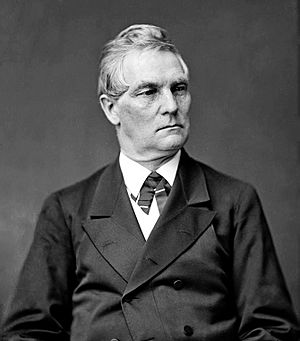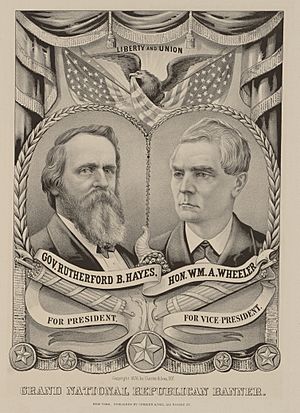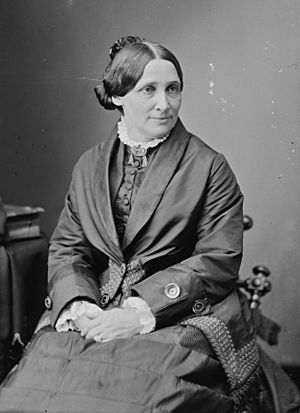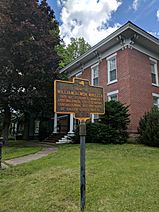William A. Wheeler facts for kids
Quick facts for kids
William A. Wheeler
|
|
|---|---|

Wheeler in 1877
|
|
| 19th Vice President of the United States | |
| In office March 4, 1877 – March 4, 1881 |
|
| President | Rutherford B. Hayes |
| Preceded by | Henry Wilson |
| Succeeded by | Chester A. Arthur |
| Member of the U.S. House of Representatives from New York |
|
| In office March 4, 1869 – March 3, 1877 |
|
| Preceded by | Calvin T. Hulburd |
| Succeeded by | Amaziah B. James |
| Constituency | 17th district (1869–73) 18th district (1873–75) 19th district (1875–77) |
| In office March 4, 1861 – March 3, 1863 |
|
| Preceded by | George Palmer |
| Succeeded by | Orlando Kellogg |
| Constituency | 16th district |
| Member of the New York Senate from the 17th district |
|
| In office January 1, 1858 – December 31, 1859 |
|
| Preceded by | Joseph H. Ramsey |
| Succeeded by | Charles C. Montgomery |
| Member of the New York State Assembly from the Franklin County district |
|
| In office January 1, 1850 – December 31, 1851 |
|
| Preceded by | George Gove |
| Succeeded by | Darius Lawrence |
| Personal details | |
| Born |
William Almon Wheeler
June 30, 1819 Malone, New York, U.S. |
| Died | June 4, 1887 (aged 67) Malone, New York, U.S. |
| Resting place | Morningside Cemetery, Malone, New York, U.S. |
| Political party | Whig Republican |
| Spouse |
Mary King
(m. 1845; |
| Education | University of Vermont (BA) |
| Profession | Attorney |
| Signature | |
William Almon Wheeler (June 30, 1819 – June 4, 1887) was an American politician and lawyer. He is best known for serving as the 19th Vice President of the United States from 1877 to 1881. Before becoming Vice President, he was a U.S. Representative for New York from 1861 to 1863 and again from 1869 to 1877.
Wheeler was born in Malone, New York. He studied law after attending the University of Vermont. He held several local jobs and then was elected to the New York State Legislature. People respected him for being very honest. He even refused a pay raise that Congress passed in 1873 because he didn't agree with it.
In 1876, the Republican Party chose Rutherford B. Hayes as their presidential candidate. They then picked Wheeler to be his running mate (the vice presidential candidate). Wheeler was popular among other politicians and had avoided making enemies. He was also from New York, a large state, which helped balance the ticket since Hayes was from Ohio. Hayes and Wheeler won the 1876 United States presidential election, even though they lost the popular vote. Wheeler and Hayes got along well during their time in office. They both decided not to run for a second term. After his time as Vice President, Wheeler went back to Malone, New York, where he passed away in 1887. He was buried in Morningside Cemetery.
Contents
Early Life and Political Beginnings
William Almon Wheeler was born in Malone, New York. He went to Franklin Academy and the University of Vermont. He had to leave college early because he needed to earn money. Later, he received special honorary degrees from Dartmouth College, the University of Vermont, and Union College. In 1876, he officially earned his Bachelor of Arts degree from the University of Vermont. In 1845, he married Mary King.
Wheeler studied law with Asa Hascall, a lawyer and politician in Malone. In 1845, Wheeler became a lawyer and started his own practice in Malone. He served as the District Attorney for Franklin County from 1846 to 1849. He was also a member of the New York State Assembly in 1850 and 1851. Later, he served in the New York State Senate from 1858 to 1859.
Wheeler was elected as a Republican to the U.S. House of Representatives. He served two separate periods: from March 4, 1861, to March 3, 1863, and again from March 4, 1869, to March 3, 1877. While in the House, he led important committees, including the Committee on Pacific Railroads and the Committee on Commerce.
Wheeler was known for his strong honesty. Once, a powerful New York politician named Roscoe Conkling offered him anything he wanted in New York politics if Wheeler would join his group. Wheeler famously replied that nothing in New York could make him lose his self-respect.
Wheeler also served as president of New York's Northern Railroad. He was also the president of the New York State Constitutional Convention, which met from 1867 to 1868.
In 1873, Congress voted to give themselves a pay raise, and it was even made effective for the past five years. This was called the Salary Grab Act. Wheeler not only voted against this raise, but he also returned his extra salary money to the government.
Wheeler was also involved in the Wheeler Compromise of 1875. This agreement helped calm a difficult political situation in Louisiana. However, it also led to federal troops leaving the South, which marked the end of the Reconstruction period.
The Election of 1876
Wheeler was a delegate at the 1876 Republican National Convention. At this meeting, Rutherford B. Hayes was chosen as the Republican candidate for president.
Wheeler was seen as a good choice for Vice President because he was well-liked and hadn't made many enemies in his political career. When it was time to pick a vice presidential candidate, Congressman Luke P. Poland nominated Wheeler. Wheeler quickly took the lead over other candidates. By the time the votes from New York were counted, it was clear Wheeler would win. He received 366 votes, much more than his closest rival, Frederick T. Frelinghuysen.
When Governor Hayes heard that Wheeler was his running mate, he famously wrote to his wife, Lucy, saying: "I am ashamed to say: Who is Wheeler?" Hayes and Wheeler had not worked together in the House of Representatives, so Hayes didn't know him.
At the Republican Convention, there was a discussion about the party's plans for the South. Some, including Hayes and Wheeler, wanted to change the focus from Reconstruction efforts to trying to build better relationships with Southern politicians.
Vice Presidency (1877–1881)
William Wheeler became Vice President on March 4, 1877, and served until March 4, 1881.
Wheeler's wife had passed away a year before he became Vice President, so he was a widower. He was often invited to meals at the White House. As Vice President, he was the president of the Senate. President Hayes said that Wheeler was one of the few Vice Presidents who were truly good friends with the President.
Hayes had announced early in his term that he would not run for president again. Wheeler also decided not to seek the Republican presidential nomination in 1880. He retired from politics at the end of his term.
Lucy Hayes' Fishing Trip (1878)
First Lady Lucy Webb Hayes and her husband felt it was important to include the lonely Vice President Wheeler in their social life. Wheeler was very thankful for their kindness. In the spring of 1878, he invited Lucy to go on a fishing trip with him in the Adirondacks. Lucy agreed and joined him on May 31. On their first day, they caught a very large trout that weighed about 13 pounds. Wheeler sent it to President Hayes, who jokingly telegraphed back that he thought it was more like 13 ounces. Hayes was actually surprised by the fish's size and had it served at a dinner with his cabinet members and senators.
The next day, as Wheeler and Lucy were traveling back to Malone, a group of children waved red flags at them. Wheeler was touched and stopped their carriage so Lucy could meet the children. The trip lasted eleven days. When Lucy and her daughter returned to Washington, she wrote to Wheeler to thank him for "a wild and joyous time."
After the Vice Presidency (1881–1887)
After his term as Vice President ended on March 4, 1881, Wheeler retired to Malone. In May 1881, two U.S. Senators from New York resigned. This led to special elections to fill their seats. Wheeler's name was considered for these positions, and he received some votes. However, other candidates were eventually chosen.
Wheeler had health problems throughout his life, and his health got worse in his later years. He passed away at his home on June 4, 1887. His funeral was held at the Congregational church in Malone. He was buried next to his wife in Morningside Cemetery in Malone.
Images for kids
See also
 In Spanish: William A. Wheeler para niños
In Spanish: William A. Wheeler para niños





